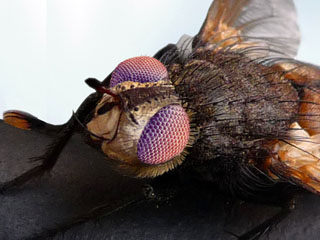Early Design in Eyes from Shrimp-like Anomalocaris

Introduction

Anomalocaris
The giant predatory crustacean has been named Anomalocaris ("strange shrimp"). Although it had long grasping claws, the characteristic that made it a formidable predator was its acute eyesight. At a time soon after eyes had appeared on earth, Anomalocaris possessed two large compound eyes about one inch in diameter, containing at least 16,000 lenses. Since the fossil was compressed, it is possible that the eyes may have had up twice as many lenses. By comparison, today's housefly has only 3,200 lenses and an ant has less than 1,000. The only arthropod that comes close to Anomalocaris is the predatory dragonfly, with 28,000 lenses in each eye. Compound eyes work best at detecting motion (which is why it is so difficult to dispatch those pesky houseflies from your house). As each in a series of lenses detects motion, it sends a signal to the brain, which can figure out the speed and direction of potential prey or enemies. The implication for Anomalocaris was that it had a well-developed brain, in order to process the input from a least 32,000 compound eyes.
Implications for evolution
Gradualism, the theory that biological evolution results from descent with modification based upon slowly incorporated changes in body plans, would suggest that one would see a gradual change in complexity of life on earth throughout its history. Instead, what are seen in the fossil record are rapid, gross changes in anatomy followed by stasis (lack of change). The Cambrian explosion was a case in point, since all the earth's animal phyla appeared in a virtual geologic instant. Eyesight is said to have rapidly evolved as predator and prey evolved in an ever increasing war for supremacy. Anomalocaris was the apparent victor in the war, since they survived at least 35 million years unchanged (from 515 to 480 million years ago). Beyond the rapid evolution of compound eyes in the Cambrian era was the requirement that primitive brains of those animals also evolve rapidly in order to process the incredible number of simultaneous neural signals coming from the 32,000 compound eyes of Anomalocaris. One could plausibly accept the evolution of such a number of lenses and the brain power to use it over a period of a couple hundred million years for the dragonfly. However, to find such a highly developed predator in the Cambrian era stretches the credulity of evolutionary theory.
Conclusion 
Anomalocaris is an amazingly designed shrimp-like predatory crustacean that lived during the Cambrian era. Besides its large size and formidable claws, it possessed acute vision, with binocular compound eyes containing at least 32,000 lenses to detect even the slightest motion of potential prey. The fossil find is surprising to evolutionists, since it implies the rapid evolution of compound eyes and the neural nets to process the information, only a few tens of millions of years after the first animal life appeared in the seas.
Related Pages 
- General Rebuttal to the Theory of Evolution
- The Origin of Biological Information and the Higher Taxonomic Categories
- Demise of the "Birds are Dinosaurs" Theory
- Tetrapod Tracks Overturn Reigning Evolutionary Theory on Fish-Tetrapod Transition
Related Materials 
 Origins of Life:
Biblical and Evolutionary Models Face Off
Origins of Life:
Biblical and Evolutionary Models Face Off![]() by Fazale Rana and Hugh Ross. Probably the single most potent
scientific argument against atheism is the problem with a naturalistic origin of
life. This very problem led me to become a deist as a biology major at USC in
the early 1970's. The problems for atheists have gotten no better since that
time. In fact, the last 30+ years of research have turned up even more problems
than those that existed when I first studied the theories. Fuz Rana (a
biochemist) and Hugh Ross (an astrophysicist) have teamed up to write the
definitive up-to-date analysis of the origin of life. The book examines the origins of life from the
perspectives of chemistry, biochemistry, astronomy, and the Bible. A biblical
creation model is presented along side the naturalistic models to help the
reader decide which one fits the data better. This is an excellent book to give
to your unbelieving friends, since it presents a testable creation model that is
clearly superior to any naturalistic model.
by Fazale Rana and Hugh Ross. Probably the single most potent
scientific argument against atheism is the problem with a naturalistic origin of
life. This very problem led me to become a deist as a biology major at USC in
the early 1970's. The problems for atheists have gotten no better since that
time. In fact, the last 30+ years of research have turned up even more problems
than those that existed when I first studied the theories. Fuz Rana (a
biochemist) and Hugh Ross (an astrophysicist) have teamed up to write the
definitive up-to-date analysis of the origin of life. The book examines the origins of life from the
perspectives of chemistry, biochemistry, astronomy, and the Bible. A biblical
creation model is presented along side the naturalistic models to help the
reader decide which one fits the data better. This is an excellent book to give
to your unbelieving friends, since it presents a testable creation model that is
clearly superior to any naturalistic model.
References 
- Chen, J.Y., J. Dzik, G.D. Edgecombe, L. Ramskold, G.Q. Zhou. 1995. A possible early Cambrian chordate. Nature 377: 720-722.
- Setting the Stage for Life: Scientists Make Key Discovery About the Atmosphere of Early Earth. Rensselaer Polytechnic Institute press release.
- M. T. Rosing. 1999. 13C-Depleted Carbon Microparticles in >3700-Ma Sea-Floor Sedimentary Rocks from West Greenland. Science 283, 674.
http://www.godandscience.org/evolution/early_crustacean_eyes.html
Last Modified December 11, 2011



